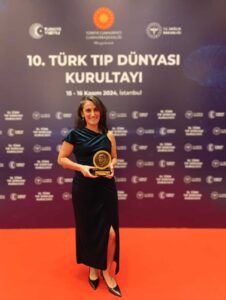Turkish scientist and Massachusetts Institute of Technology (MIT) associate professor Canan Dağdeviren has made history by sending her groundbreaking wearable ultrasound device into space, Turkish media reported on Tuesday, citing the academic.
The conformable Ultrasound Breast Patch (cUSBr-Patch), designed by Dağdeviren to allow for frequent, non-invasive breast cancer screenings, was launched on Monday with a six-woman crew, the professor announced on social media.
According to the professor’s Instagram account, Amanda Nguyen, the first Vietnamese-American astronaut, took the wearable ultrasound patch to space with the first-ever only female crew space flight in history.
She said the wearable ultrasound patch is designed for operator-independent, large-area imaging, which could enable continuous health monitoring in space. The ultrasound array will be deployed to evaluate the performance of the device both pre and post-flight.
“Our long-term goal is to develop a wearable garment with embedded ultrasound to monitor musculoskeletal deconditioning and spine elongation in astronauts,” Dağdeviren wrote.
The 10-minute suborbital flight, backed by Jeff Bezos’s aerospace company, Blue Origin, marked a milestone not only in spaceflight but also in medical innovation.
“Let this go down in history. Today … I sent my wearable ultrasound device into space with the first all-female space crew in history,” Dağdeviren wrote on X.
“Yes, the future is in the skies,” she added, referencing a famous quote by Mustafa Kemal Atatürk, the founder of modern Turkey.
Dağdeviren is a physicist, material scientist and assistant professor at MIT, where she currently holds the LG Career Development Professorship in Media Arts and Sciences. She is also the first Turkish scientist to become a Junior Fellow in the Society of Fellows at Harvard University. Her innovation, the cUSBr-Patch, is a palm-sized, flexible ultrasound scanner that fits inside a bra and allows for real-time breast tissue monitoring — potentially catching tumors before they become life-threatening.

In an interview with the Falling Walls Foundation last year, Dağdeviren said the inspiration for her soft, wearable ultrasound imaging bra/patch came during her aunt’s battle with stage 4 interval breast cancer. Before losing her in 2015, she sketched the first concept of the device at her aunt’s bedside.
“Together, we sketched a device that would allow women to conduct breast scans at home. This vision fueled my academic journey, transforming a simple sketch into reality,” she added.
Unlike mammograms, which are recommended every two to three years and use radiation, the cUSBr-Patch offers a safer, more frequent alternative. It captures data from the same spot consistently and can detect anomalies as small as 0.3 centimeters.
Researchers involved in the study designed a flexible, 3D-printed patch with honeycomb-like openings to make the device wearable. The patch attaches to a bra with openings that allow it to touch the skin, where it can scan breast tissue.
In July 2023 her team published a proof-of-concept study in Science Advances after testing the patch on a 71-year-old woman with a history of breast cysts. The patch was able to scan tissue up to 8 centimeters deep, comparable to traditional ultrasound systems.
Breast cancer is the most common cancer among women worldwide. When detected early, the survival rate is nearly 100 percent, but it drops to 25 percent if diagnosed at a later stage, making early detection critical. Dağdeviren hopes her device will ultimately make breast cancer screening more affordable and accessible, particularly for underserved populations, including women in lower-income countries and those at higher risk. She says the technology has the potential to save up to 12 million lives a year.



